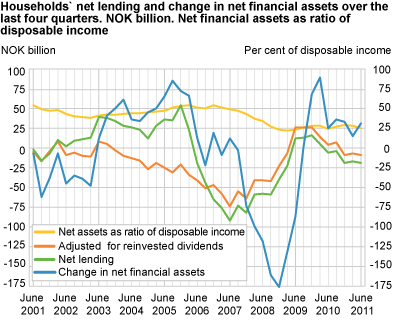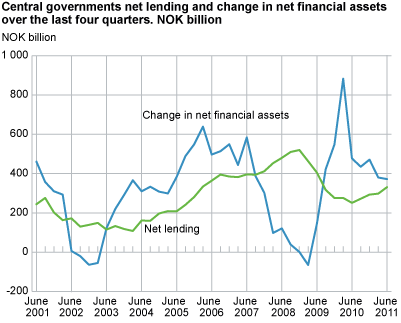Content
Published:
This is an archived release.
Debt as ratio of disposable income increases
Households and non-profit institutions serving households’ debt continues to increase faster than income. The seasonally-adjusted debt-income ratio increased by 0.4 percentage points in the second quarter of 2011 to 203.0 per cent of disposable income at the end of the quarter.
Households’ net lending totalled over the four last quarters fell from the fourth quarter of 2009 to the fourth quarter of 2010, but this development has flattened out in the first half of 2011. In the four-quarter period to the second quarter 2011, net lending is calculated to NOK -19 billion. This is on a level with net lending in the two previous four-quarter periods.
Households increase borrowing from financial corporations
Households borrowed NOK 152 billion in the last four-quarter period. This is up almost NOK 6 billion from the four-quarter period to the first quarter of 2011. The growth in total debts is calculated to 6.7 per cent, which is 0.1 percentage points higher compared to the previous four-quarter period. Lending from financial corporations to households showed the highest growth, while other accounts payable increased less and subdued the growth in households’ total debt.
Investments in financial assets over the four last quarters amounted to NOK 133 billion. This is up NOK 3.5 billion from the previous four-quarter period. In the last four-quarter period, households increased their bank deposits, while investments in securities slowed down compared to the four-quarter period to the first quarter of 2011. This is explained by net sale of bonds, shares and mutual fund shares in the second quarter of 2011.
Households’ net financial assets fell by NOK 34 billion in the second quarter of 2011. Net financial assets are estimated to NOK 310 billion at the end of the last quarter and constituted 68 per cent of net financial assets at the end of the second quarter of 2007, before financial turmoil and the financial crisis caused large net holding losses.
State’s net financial assets fell in last quarter
Central government’s net financial assets fell by NOK 37 billion in the second quarter of 2011. Both strong foreign exchange rates and negative developments in domestic and foreign securities markets contributed to the fall. In the last four-quarter period, net lending was NOK 331 billion. Holding losses in the second quarter and exchange rate developments in foreign exchange rates in the first half of 2011 simultaneously contributed to bringing down holding gains to NOK 41 billion in the four-quarter period. Central government’s net financial assets increased by NOK 372 billion in the last four-quarter period and the state’s net financial assets amounted to NOK 4 279 billion at the end of the second quarter of 2011.
Modest fall in local government debt
Local government’s net lending shows a modest fall by NOK 1 billion to NOK -25 billion in the four-quarter period to the second quarter of 2011. The development is explained by a moderate fall in both borrowing and investments in financial assets. In the last four-quarter period, borrowing amounted to NOK 36 billion compared to NOK 42 billion in the previous four-quarter period. Local government debt has increased every quarter since the end of 2007, but in the last quarter local government debt was reduced by NOK 2 billion. The debt amounted to NOK 434 billion at the end of the second quarter of 2011 compared to NOK 436 billion at the end of the previous quarter. The debt development is burdened by incomplete estimates of internal debt in local government. Investments in financial assets amount to NOK 10 billion in the four-quarter period to the second quarter of 2011. This is down NOK 8 billion compared to the previous four-quarter period.
Net holding losses abroad
Norway’s net foreign assets were calculated to NOK 2 459 billion at the end of the second quarter of 2011. This is up by NOK 74 billion from the end of the first quarter of 2011. Norway’s net lending abroad was NOK 85 billion in the second quarter of 2011, which is down by NOK 9 billion from the first quarter of 2011. Net holding losses due to exchange rate developments in foreign exchange and global security markets reduced the value of net financial assets abroad by NOK 11 billion in the second quarter of 2011.
| Q1 2009 | Q2 2009 | Q3 2009 | Q4 2009 | Q1 2010 | Q2 2010 | Q3 2010 | Q4 2010 | Q1 2011 | Q2 2011 | ||||||||||||||||||||||||||||||||||||||||||||||||||||||||||||||||||||||
|---|---|---|---|---|---|---|---|---|---|---|---|---|---|---|---|---|---|---|---|---|---|---|---|---|---|---|---|---|---|---|---|---|---|---|---|---|---|---|---|---|---|---|---|---|---|---|---|---|---|---|---|---|---|---|---|---|---|---|---|---|---|---|---|---|---|---|---|---|---|---|---|---|---|---|---|---|---|---|---|
| Financial assets | 5 923 | 6 096 | 6 077 | 6 059 | 6 379 | 6 716 | 6 663 | 6 877 | 7 069 | 6 992 | |||||||||||||||||||||||||||||||||||||||||||||||||||||||||||||||||||||
| Liabillities | 4 554 | 4 390 | 4 190 | 4 174 | 4 285 | 4 515 | 4 375 | 4 486 | 4 685 | 4 533 | |||||||||||||||||||||||||||||||||||||||||||||||||||||||||||||||||||||
| Net financial assets/net financial wealth | 1 369 | 1 706 | 1 887 | 1 885 | 2 093 | 2 202 | 2 287 | 2 391 | 2 384 | 2 459 | |||||||||||||||||||||||||||||||||||||||||||||||||||||||||||||||||||||
| Change in net financial assets/net financial wealth | -165 | 337 | 181 | -2 | 208 | 108 | 86 | 104 | -7 | 75 | |||||||||||||||||||||||||||||||||||||||||||||||||||||||||||||||||||||
| Other changes | -207 | 255 | 118 | -89 | 124 | 35 | 21 | 18 | -83 | -11 | |||||||||||||||||||||||||||||||||||||||||||||||||||||||||||||||||||||
| Net lending | 41 | 81 | 63 | 88 | 84 | 74 | 65 | 86 | 76 | 85 | |||||||||||||||||||||||||||||||||||||||||||||||||||||||||||||||||||||
DefinitionsNet lending as defined in non - financial accounts ( capital account ) = savings + net capital transfers - net acquisition of non - financial assets Net lending as defined in financial accounts = net acquisition of financial assets - net incurrence of liabilities Savings is non-consumed income and can be invested in financial or non-financial assets. If savings exceed non-financial investments, a sector has a surplus of funds and becomes a net lender to other sectors. In the financial transaction account, this means that the sector acquires more financial assets than liabilities. On the other hand, if savings are less than non-financial investments, investments have to be funded either by selling financial assets or incurring debts. Household investments in non-financial assets mainly reflect the purchase of new housing and fixed investments by unincorporated enterprises. They typically finance substantial parts of these investments by incurring debt in the form of loans. Net financial assets ( net financial wealth ) = total financial assets - total liabilities The financial balance sheet shows the financial position of a sector at the end of the reference period and is broken down into the categories of financial assets and liabilities. Insurance technical reserves, currency and deposits are the predominant assets held by households, while loans provided by financial corporations (banks etc.) constitute the main proportion of liabilities. Changes in net financial assets = net lending + other changes in assets , net The change in the financial balance sheet during the reference period is a result of accumulated financial transactions and other changes in assets. The latter category mainly reflects revaluations due to changes in market prices of financial instruments. |
Contact
-
Torbjørn Cock Rønning
E-mail: torbjorn.cock.ronning@ssb.no
tel.: (+47) 97 75 28 57
-
Jon Ivar Røstadsand
E-mail: jon-ivar.rostadsand@ssb.no
tel.: (+47) 21 09 43 69
-
Marit Eline Sand
E-mail: marit.sand@ssb.no
tel.: (+47) 40 90 26 74


